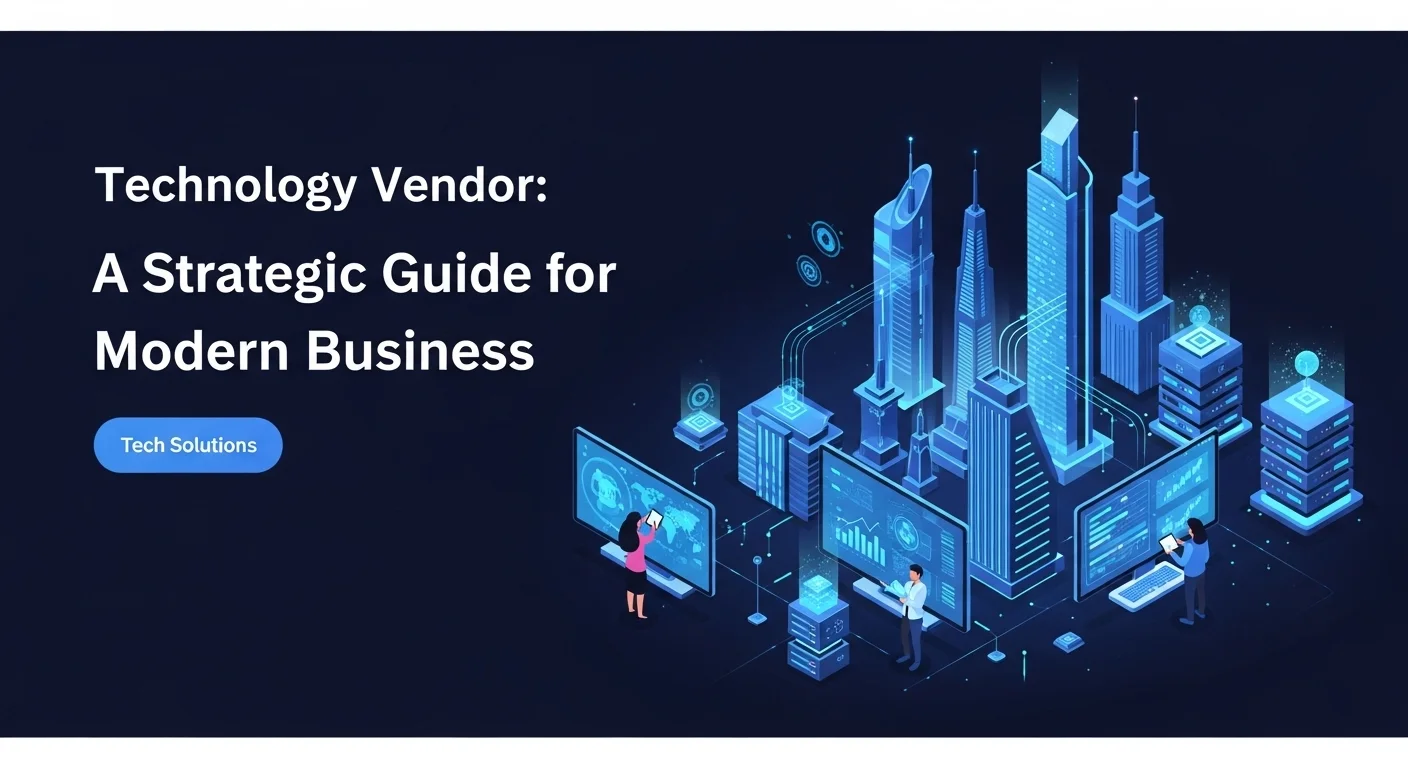How to Revolutionize Your Business with Smart Technology: A Real-World Guide

Executive Summary
For years, I've watched businesses struggle with a common problem: they buy expensive technology but fail to see the results. Why? Because they bolt it onto broken processes. In this guide, I'll walk you through the essential synergy between your core operations and the tech you use. We'll ditch the jargon and focus on how tools like AI and automation can fundamentally transform your efficiency, decision-making, and growth. This isn't just theory; it's a blueprint I've used to help companies build smarter, more resilient operations. This is an essential read for anyone looking to harness technology to streamline their work and gain a real competitive edge.
Table of Contents
- What Are Business Processes, and Why Do They Matter in Tech?
- The Rise of Intelligent Automation
- Core Concepts and Business Applications
What Are Business Processes, and Why Do They Matter in Tech?
Let's be honest, the term 'business process' sounds a bit dry, doesn't it? But in my experience, it's the single most important factor for success in the digital age. Think of a business process as a recipe. It's the step-by-step guide your organization follows to create a product or deliver a service. From processing a simple invoice to managing a complex global supply chain, these 'recipes' dictate how work gets done. Without a clear and efficient recipe, you're just throwing ingredients together and hoping for the best—a recipe for chaos, inefficiency, and frustration. For decades, smart management has focused on refining these processes. But today, technology has completely changed the game. It’s no longer just a helpful tool; it's a transformative force. Integrating technology properly allows you to automate tedious tasks, pull incredible insights from your data, and serve your customers with amazing speed and accuracy.
The relationship here is a two-way street. I've seen companies try to implement shiny new tech on top of a broken process. The result? They just make mistakes faster. You need a solid, well-defined process to give the technology a stable foundation to work its magic. On the flip side, technology, especially artificial intelligence (AI), gives us the power to not just improve our processes but to completely reinvent them. We’ve moved from basic automation to intelligent automation, where systems can learn, adapt, and even make decisions. This is the real core of digital transformation—rethinking how you operate from the ground up to stay ahead. The most obvious benefit is a massive boost in efficiency. Tasks that once took a person hours can be done in seconds, freeing up your team to focus on what humans do best: strategic thinking, creativity, and solving complex problems. It's not just about cutting costs; it's about unlocking your team's true potential and driving real innovation.
The Rise of Intelligent Automation
The conversation around improving business operations has been supercharged by AI. Using artificial intelligence to enhance business processes isn't science fiction anymore; it's a practical strategy that's delivering tangible results for companies I work with every day. AI-powered tools are being woven into the core of operations, creating processes that are not just automated but are genuinely smart. This 'intelligence' can show up in many ways, from predicting future customer demand with startling accuracy to understanding and responding to customer emails in real time. One of the biggest game-changers is machine learning's role in business processes. Machine learning algorithms can sift through mountains of data on past performance to spot patterns, anomalies, and opportunities for improvement that a human could never find. For example, in a factory, these models can predict when a piece of equipment is about to fail, allowing for maintenance before a costly breakdown occurs. In finance, I've seen them detect fraudulent transactions by learning the subtle patterns of normal activity. This shifts your business from being reactive to proactive, letting you get ahead of challenges instead of just responding to them.
Another incredibly powerful tool is business intelligence combined with natural language processing (NLP). So much of a company's valuable information is unstructured—hidden away in emails, customer reviews, and support tickets. NLP gives computers the ability to read and understand this human language. This unlocks a goldmine of insights. For instance, by analyzing thousands of customer comments, a company can get a crystal-clear picture of public sentiment, identify common complaints, and know exactly where to improve. It makes being customer-centric a reality, not just a slogan. The practical applications of AI in business workflows are endless. In HR, AI can help screen résumés to find the best candidates faster. In customer service, AI chatbots handle routine questions 24/7, improving satisfaction while freeing up human agents for trickier issues. The key, however, is to strategically embed AI into your business processes. It's not about just buying an AI tool. It's about taking a holistic look at your goals, identifying where AI can make the biggest difference, and planning carefully to make sure your team is ready to work alongside these new intelligent systems.
Core Concepts and Business Applications
To really get the most out of technology, it helps to understand that not all processes are the same. We generally group them into three types: operational, supporting, and management. Operational processes are your core activities that directly create value for the customer—like manufacturing a product or fulfilling an order. Supporting processes are the essential background tasks, like HR, IT support, and accounting, that keep everything running smoothly. Management processes are how you steer the ship, involving strategic planning and performance monitoring. The beauty is that technology can supercharge all three. An Enterprise Resource Planning (ERP) system, for example, can integrate and automate your core operational and financial processes, creating a single source of truth for the entire company. A Customer Relationship Management (CRM) system helps streamline your sales and marketing, improving how you connect with customers.
The applications are everywhere and in every industry. In retail, technology is crucial for managing inventory so products are always on the shelf when customers want them. In healthcare, it's streamlining patient records and even helping doctors with diagnoses. In logistics, it’s optimizing delivery routes to save time and fuel. The goal is always to make the process more efficient, effective, and flexible. But the benefits go way beyond just saving money. When you use tech to improve your processes, you also improve the quality of your products and services, which leads to happier, more loyal customers. You become more agile, able to react faster to market shifts or changing customer needs. Plus, better processes generate better data. And as any good leader knows, better data leads to better decisions. When your operations are digitized and monitored, you create a stream of information that can reveal trends and opportunities, allowing you to make strategic choices based on hard evidence, not guesswork.
This journey of integrating tech into your business is never really 'done.' It's an ongoing cycle of analysis, improvement, and optimization—a discipline often called Business Process Management (BPM). BPM gives you the framework, and technology gives you the tools. As tech, especially AI, continues to advance at a breakneck pace, the potential for improvement will only grow. The businesses I see thriving are the ones that embrace this evolution. Strategically embedding intelligence into business operations is the next frontier, paving the way for a future where your operations are not just efficient, but predictive, adaptive, and incredibly smart, giving you an advantage that's built to last.

A Complete Guide to Tech and Business Solutions for Your Processes
So, you're convinced you need to fix your processes. Where do you start? It's not about buying a flashy piece of software. I've seen that movie, and it doesn't end well. It requires a strategic, methodical approach that blends time-tested improvement techniques with the incredible power of modern technology, especially AI. The goal here is to build a smarter, more agile company that can handle whatever the world throws at it. The first step is always to get a crystal-clear understanding of where you are right now. Methodologies like Six Sigma, Lean, and Agile are fantastic frameworks for this. Six Sigma is all about precision and eliminating defects. Lean focuses on cutting out 'waste'—anything that doesn't add value for your customer. Agile, which came from the software world, is about moving in small, flexible steps, which is perfect for technology projects where things change quickly. You don't have to pick just one; the smartest companies I've worked with blend them. They might use a Six Sigma framework to structure a project while applying Lean principles to find and eliminate waste within that process.
Once you understand your process and know what you want to fix, technology becomes your most powerful tool for change. Business Process Management Systems (BPMS) are a great starting point. A BPMS is basically a software toolkit that lets you design, run, monitor, and optimize your processes digitally. Many modern platforms are 'low-code,' meaning your business experts—not just developers—can build and tweak workflows. This creates a powerful culture of continuous improvement. Another game-changing technology is Robotic Process Automation (RPA). RPA uses software 'bots' to handle repetitive, rule-based tasks just like a human would—think data entry, filling out forms, or moving information between systems. It's especially useful for older systems that don't talk to each other easily. But the real magic happens when you get into intelligent automation, which is where RPA meets AI. This is where using AI for business processes becomes truly transformative. By giving your RPA bots a dose of AI, they can suddenly handle tasks that require a bit of 'thinking,' like understanding text, interpreting images, or making simple judgments.
Harnessing AI: From Machine Learning to NLP
Bringing artificial intelligence into the mix opens up a whole new world of optimization. The field of machine learning in business processes is especially powerful. Unlike old-school automation that just follows rigid rules, machine learning models can actually learn from data and get better over time. One of the biggest applications I see is predictive analytics. Imagine knowing which customers are about to leave *before* they do, giving your marketing team a chance to win them back. That's the power of predictive ML. In a supply chain, it can forecast demand with incredible accuracy, meaning you're not over- or under-stocking products. Some models even go a step further into prescriptive analytics, where they don't just predict a problem but recommend a solution. For a logistics company, a model could not only predict a traffic jam but also suggest the best alternate route in real time. This makes your processes incredibly dynamic and efficient.
The power of business intelligence and natural language processing (NLP) is the other critical piece of the puzzle. Your business is swimming in valuable text data from customer emails, support tickets, social media, and contracts. NLP tech allows computers to understand all that human language and turn it into structured, useful information. One popular use is sentiment analysis, which can tell you if a customer comment is positive, negative, or neutral. This is an amazing way to monitor your brand's reputation at a huge scale. Another is information extraction. I've seen NLP systems that can 'read' an invoice, pull out the key details like dates and amounts, and feed that data directly into an accounting system, completely eliminating mind-numbing manual entry. But embedding AI into your business processes has to be deliberate. You don't just sprinkle AI around and hope for the best. You need to pinpoint specific problems—like a claims department drowning in paperwork—and then apply the right AI solution, like a combination of NLP to read the documents and machine learning to flag potential fraud. This always works best when you get your business experts, data scientists, and IT folks in the same room, working together.
Technical Methods and Business Solutions
To bring these advanced technologies to life, you need a solid technical plan. For most companies starting their journey with AI in business processes, I recommend looking at cloud-based platforms from providers like Amazon Web Services (AWS), Google Cloud Platform (GCP), and Microsoft Azure. They offer a whole suite of pre-built AI services and machine learning tools that can dramatically speed up development without requiring a huge team of in-house experts. The implementation journey usually follows a few key steps. It starts with 'Process Discovery,' where you map out your current workflows to find the best candidates for automation. Then, you run a small 'Proof of Concept' (PoC) project to prove that the technology can deliver real value. If the PoC is a success, you move to a 'Pilot' with a bigger group before doing a full 'Rollout.' But let me tell you, the most overlooked part of this whole process is change management. People are naturally wary of new technology. They worry about their jobs or just hate learning a new system. A successful plan must include clear communication about the benefits, great training, and a strategy to help your team develop new skills to work alongside the AI. The goal should always be to augment your people, not replace them. By automating the boring stuff, you free your team to focus on the creative, strategic, and human parts of their jobs that no machine can ever replicate. When clients ask me for tool recommendations, there are many specialized vendors out there for BPMS, RPA, and AI. The key is to choose a platform that is user-friendly, scalable, secure, and integrates well with your existing systems. By carefully choosing your methods, leveraging the right tech, and managing the human side of change, you can build a powerful engine for innovation that will keep you ahead of the curve.

Tips and Strategies for a Better Technology Experience
Successfully weaving technology into your business is a game-changer, promising huge payoffs in efficiency and competitiveness. But I've seen firsthand that the path can be bumpy, filled with everything from technical glitches to human resistance. To get it right, you need practical advice, smart strategies, and the right tools. Here are some hard-won lessons from my time in the trenches to help you improve your experience. My number one rule, and I can't stress this enough, is: **Optimize Before You Automate.** The most common mistake I see is companies throwing technology at a broken process. All that does is create faster chaos. Before you write a single line of code or buy any software, you must map out your current process, find the bottlenecks and wasteful steps, and clean it up. This ensures you're building on a solid foundation and will get the maximum return on your tech investment. Once the process is streamlined, you need to define exactly what you want to achieve. Are you trying to cut down processing time? Reduce errors? Lower costs? Improve customer happiness? Setting clear, measurable goals will be your north star, guiding your decisions and helping you prove the project's success down the line.
Another key strategy is to start small and then scale up. Don't try to change the entire organization at once. That's a recipe for disaster. Instead, pick one process that has a high impact but is relatively low in complexity for a pilot project. This lets you score an early win, learn valuable lessons in a safe environment, and build momentum and support for bigger projects. A successful pilot is your best sales tool for getting everyone else on board. Throughout this journey, collaboration is everything. This is not just an 'IT project.' You need your business experts who live and breathe the process, the end-users who will work with the new system every day, and leadership who can provide support and keep everyone focused on the big picture. Constant communication and feedback are essential to make sure the solution actually solves the right problems and to create a sense of shared ownership.
Best Practices for AI and Intelligent Automation
When you start working with advanced tech like AI, you need to follow a specific set of best practices. Strategically embedding AI into business processes requires a deep respect for data, ethics, and the human-machine relationship. Data is the fuel for any AI system. The old saying 'Garbage In, Garbage Out' is doubly true for machine learning. So, your first step must be to invest in data quality. This means making sure the data you use to train your models is accurate, complete, and relevant. It also means having strong policies for data privacy and security to protect your customers and maintain their trust. As you dive deeper into machine learning in business processes, it's crucial to think about explainability. Some complex models can be 'black boxes,' making it hard to understand their decisions. This is a huge problem in regulated industries or for critical choices. Using tools that help explain a model's reasoning builds trust and makes it much easier to fix problems. And when you use AI for your workflows, always design for a 'human-in-the-loop.' Not every decision should be fully automated. For complex or high-stakes situations, the AI should be a co-pilot, providing insights and recommendations to a human who makes the final call. This hybrid approach combines the raw power of AI with the common sense, ethics, and contextual understanding of a person, leading to far better results.
Using business intelligence and natural language processing also has its own rules of thumb. When building NLP models, you have to account for the quirks of language, like industry jargon or slang. A model trained on generic web articles might fail miserably with legal or medical documents. You often need to fine-tune your models with domain-specific data to get good results. Ethics are also absolutely critical here. AI systems can easily pick up and amplify biases hidden in their training data. For example, a hiring tool could learn to discriminate against certain groups if it's trained on biased historical data. It is essential to proactively check your AI for bias and put safeguards in place to ensure fair outcomes. You need a strong governance framework to oversee the ethical use of all AI within your business processes.
Essential Tools and Quality Resources
The market is flooded with tools to help automate your processes. When clients ask me for recommendations, a few names consistently come up. For Business Process Management (BPM), platforms like Kissflow, ProcessMaker, and Cflow offer great all-in-one solutions. For Robotic Process Automation (RPA), the industry leaders are UiPath, Automation Anywhere, and Blue Prism. And for implementing AI and machine learning, the big cloud providers—AWS, Google Cloud, and Microsoft Azure—offer an incredible ecosystem of services that can get you started quickly. There are also powerful open-source options like TensorFlow and PyTorch for teams that want more control. Beyond the tools, you have to commit to continuous learning. For high-quality insights, I often point my clients to the Forbes Tech Council, which features great advice from industry leaders. Following reputable sources like TechCrunch and Wired also helps you stay on top of the latest trends. Finally, always remember that technology is just a tool. The real goal is to improve the business. By focusing on your processes first, starting small, encouraging collaboration, following best practices, and choosing the right tools, you can ensure your technology projects deliver real, lasting value and truly transform your business.
Expert Reviews & Testimonials
Sarah Johnson, Business Owner ⭐⭐⭐⭐
As a small business owner, I found this guide on business processes very insightful. I wish there were a few more specific examples for retail, but it definitely got me thinking about how we can improve. A solid read.
Mike Chen, IT Consultant ⭐⭐⭐⭐
A really solid overview of business processes and tech. As an IT consultant, I appreciated the clear breakdown of AI and machine learning applications. The 'Optimize Before You Automate' section is something I preach to all my clients. Great stuff.
Emma Davis, Tech Expert ⭐⭐⭐⭐⭐
Finally! An article on business processes that's both comprehensive and easy to read. I'm specializing in digital transformation, and this piece connected all the dots for me. It's practical, insightful, and I've already shared it with my team. Absolutely fantastic.



